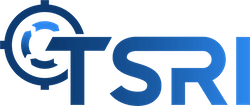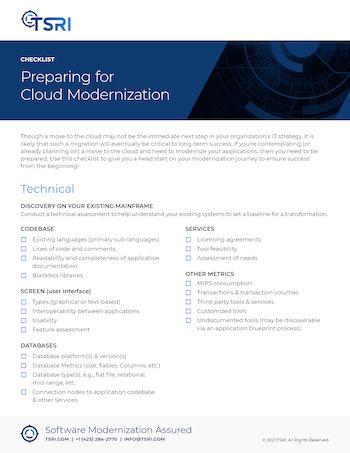René Wagner
Video: Selecting Cloud Vendors and Your Target Language
In our latest video from our Modernizing for the Future series for undertaking a cloud modernization, Scott Pickett discusses some of the decisions organizations need to consider when choosing a target language and the right cloud vendor. Some of these considerations include time-to-market and compatibility based upon your existing architecture. Scott talks through some of the ways you can make the decision that best fits your organization's needs as well as pitfalls to watch for.
Originally aired live on May 18, 2021.
Be sure to view the first two videos in this series as well.
As always, TSRI can help answer any questions you may have about modernization, automation, and making sure your systems are ready to deploy in modern computing environments.
---
TSRI is Here for You
As a leading provider of software modernization services, TSRI enables technology readiness for the cloud and other modern architecture environments. We bring software applications into the future quickly, accurately, and efficiently with low risk and minimal business disruption, accomplishing in months what would otherwise take years.
Get Started with Your Modernization!
Highlights on “Setting Project Scope” and “Setting Up Development Sandboxes”
TSRI is thrilled to present highlights from Modernizing for the Future, our cloud webinar featuring Scott Pickett, our Vice President of Product Development and Service Delivery. In these first two segments, Scott helps your organization get the mainframe modernization process started.
The first segment, “Setting Project Scope,” helps your organization understand their existing baselines, setting realistic expectations and accomplishments for your migration, and planning your target environment.
In this second segment, “Setting Up Development Sandboxes,” Scott discusses your organization’s development sandbox and why setting up an experimental environment will be critical to the success of your automated modernization. Your sandbox will help validate your target environment as well as understand any complexities in languages, architectures, or databases.
Be sure to check out the remaining videos in this series as well:
Part 3: Selecting Cloud Vendors and Your Target Language
Part 4: Using Automation to Quickly and Accurately Move to a Multi-Tier Environment
Part 5: Modernizing Using Layered Architectures
Part 6: Effective Testing During Modernizations
As always, TSRI can help answer any questions you may have about automated modernization, and making sure your systems are ready to deploy in modern computing environments.
-------
TSRI is Here for You
As a leading provider of software modernization services, TSRI enables technology readiness for the cloud and other modern architecture environments. We bring software applications into the future quickly, accurately, and efficiently with low risk and minimal business disruption, accomplishing in months what would otherwise take years.
Video: Effectively Leveraging Today's Modernization Solutions for the Cloud
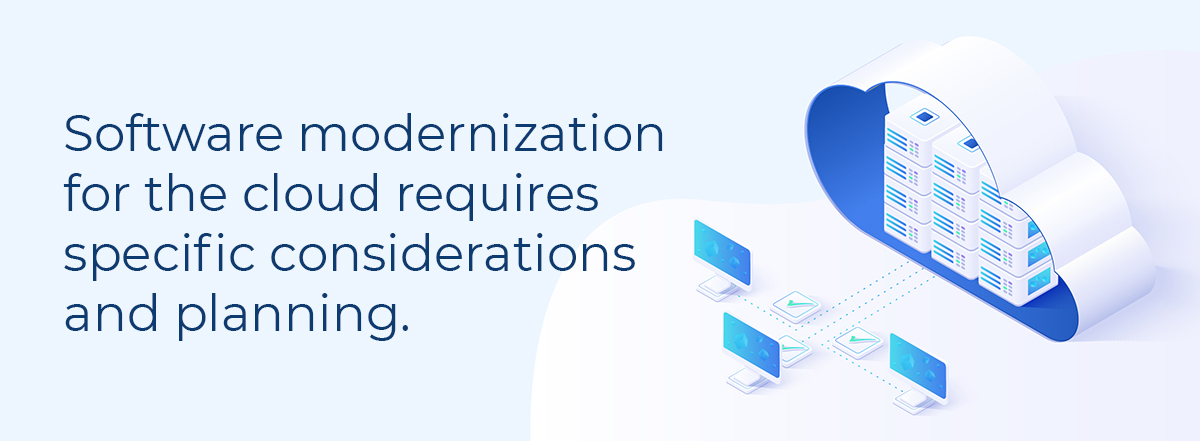
Learn tips to navigate the process in this presentation by TSRI’s VP of Product Development and Service Delivery, Scott Pickett.
Originally aired live on May 18, 2021.
Modernizing for the Future: Effectively Leveraging Today’s Modernization Solutions for the Cloud
Modernization efforts today that target cloud technologies require an understanding of the new environment up-front in the process. With a landscape of constantly evolving technology options, organizations looking to modernize their code, databases and UI, and move to the cloud are confronted with many considerations. The options are daunting, and the path to successful execution is not always clear.
Key Takeaways:
Gain important insights to successfully move beyond language modernization and support best practices for deployment in a cloud environment.
Learn about common benefits, challenges, and pitfalls in cloud migration and modernization.
Dive into the specifics associated with modernizing COBOL programs and the tools, services, and tech stacks required to support them in a modern environment.
---
TSRI is Here for You
As a leading provider of software modernization services, TSRI enables technology readiness for the cloud and other modern architecture environments. We bring software applications into the future quickly, accurately, and efficiently with low risk and minimal business disruption, accomplishing in months what would otherwise take years.
4 Tips for Modernizing with Minimal Business Disruption

Let’s face it. Change is hard. Sometimes, however, change is necessary. When it comes to modernizing mainframe systems that have been in service for decades — especially when considering the possible risks — change requires a lot of forethought.
Disruption to your organization’s business will likely be one of the biggest risk areas in question. These risks can run from prolonged periods that take your business offline to database synchronization between your existing and target applications. So how do organizations move forward with a much-needed modernization to the cloud or a hybrid on-premises solution without causing major disruptions or headaches to their business?
 Here are four tips to help you minimize business disruption risks:
Here are four tips to help you minimize business disruption risks:
1. Understand the scope of your modernization project.
Your organization may want to modernize your applications all at once, but more likely will consider a proof of concept. Great candidates for a proof of concept could be applications most critically in need of modernization, or less-utilized applications to demonstrate how a cloud or on-premises hybrid migration will holistically affect your overall systems portfolio. Understanding the application make-up and baselines of your existing applications will help uncover any additional services that may be required for a successful modernization and determine the target environment these applications will live on and language they use. Setting a realistic scope early on will give insight into which cloud services your applications can leverage, and the benefits associated with those services. Having a good understanding of the scope of the modernization before the work begins will eliminate surprises down the road as well and help prepare for subsequent steps in your organization’s modernization journey.
2. Consider a graceful migration and gradual roll-out.
With the right solution, your organization has the capability to migrate legacy systems one feature, one function, or even one API at a time. Both the existing and modernized applications can then coexist and run concurrently while maintaining or replicating the same data sources. One TSRI client actually operated in this state for over a year as we completed their modernization!
3. Put your services in the target environment under the control of your legacy environment.
Rather than remaking all of the thousands of processes that run to complete specific tasks, organizations can work on the new target environment following a code migration and create a “cloud agent” to enable the legacy mainframe system to run these processes. This temporary fix mitigates risk by eliminating the challenge of isolating problems in real time and allows organizations to move the processes from the legacy application.
4. Take advantage of automation.
Automated modernization processes eliminate the need for humans to rewrite tens (if not hundreds) of thousands of lines of code, which will inevitably introduce errors that need to be isolated and remediated. Manual rewrites can also take years. While human intervention is likely required at various points in an automated modernization, a programmer will need to touch less than .05% of a codebase, meaning issues can be remediated in hours or a few days rather than weeks. Read more about the advantages of automated modernization.
While any modernization will cause some level of disruption, a trusted partner with the experience, tools, and methods in place to migrate legacy systems will minimize risk and make your move to the cloud or a hybrid on-premises architecture as seamless as possible. An experienced, knowledgeable partner will also keep your business requirements top of mind. Remember, automated modernization and refactoring processes will update your code but do not change your business functions. Everything in your applications will perform exactly as they did prior to your modernization—and most likely better— and also enable your organization to leverage the benefits of cloud computing and the up-to-date processes modern systems offer.
---
TSRI is Here for You
As a leading provider of software modernization services, TSRI enables technology readiness for the cloud and other modern architecture environments. We bring software applications into the future quickly, accurately, and efficiently with low risk and minimal business disruption, accomplishing in months what would otherwise take years.
Modernize your High Value Assets Using Government TMF Funding
 Modernization of High Value Assets (HVAs) and software systems is more urgent than ever. In the past year, tens of millions of U.S. citizens have leveraged critical online systems to manage their livelihood and health during the COVID-19 pandemic. With such a heavy reliance on these systems, now is the time for the federal government’s critically important HVAs systems to keep up with citizens’ growing needs.
Modernization of High Value Assets (HVAs) and software systems is more urgent than ever. In the past year, tens of millions of U.S. citizens have leveraged critical online systems to manage their livelihood and health during the COVID-19 pandemic. With such a heavy reliance on these systems, now is the time for the federal government’s critically important HVAs systems to keep up with citizens’ growing needs.
The Technology Modernization Fund was established in 2017 to support government and civic agencies to bring their critical software infrastructure into the modern age. On May 12 of this year, President Biden issued a comprehensive executive order that gave direction to federal departments and agencies to strengthen the government’s cybersecurity posture. The order establishes a requirement to modernize systems and implement stronger cybersecurity standards by moving agencies and their contract partners to secure cloud services and a zero-trust architecture, which uses identity management protocols to verify that every user of a system interacts with the appropriate levels of security access. This order also mandated deployment of multifactor authentication and encryption.
According to Federal Chief Information Security Officer Chris DeRusha, the White House is pushing federal agencies toward a “zero-trust paradigm.” With the pressure on, many agencies are struggling with the magnitude of such an undertaking and are, justifiably, fearful of the perceived security and down-time risks associated with modernization.
Modernizing an HVA doesn’t have to be risky
Using a graceful, automated approach to leverage modernization solutions can result in a very low risk modernization. By implementing a step-by-step cloud migration while keeping legacy systems running in parallel, an automated modernization can happen quickly, safely, and reliably.
TSRI has over 25 years of experience undertaking migrations of this kind (see below).
- TSRI’s Work is the “Playbook” for Future Government Modernization
A large percentage of TSRI’s work over the past 25 years has been the modernization of critical government and military software applications. If fact, our recent work with HUD was called the “playbook” for future government modernization.
- Modernize Quickly and Maintain Business-as-Usual in the Process
Our technology enables HVAs to be modernized rapidly and without business disruption.
- Cloud-Ready, Cloud-certified — AWS & Beyond
As a certified AWS partner for mainframe modernization, TSRI helps organizations take advantage of the Technology Modernization Fund to transform and secure their applications for cloud deployment on AWS and other leading platforms.
- Case Study — COBOL to Java: USAF Modernization for AWS
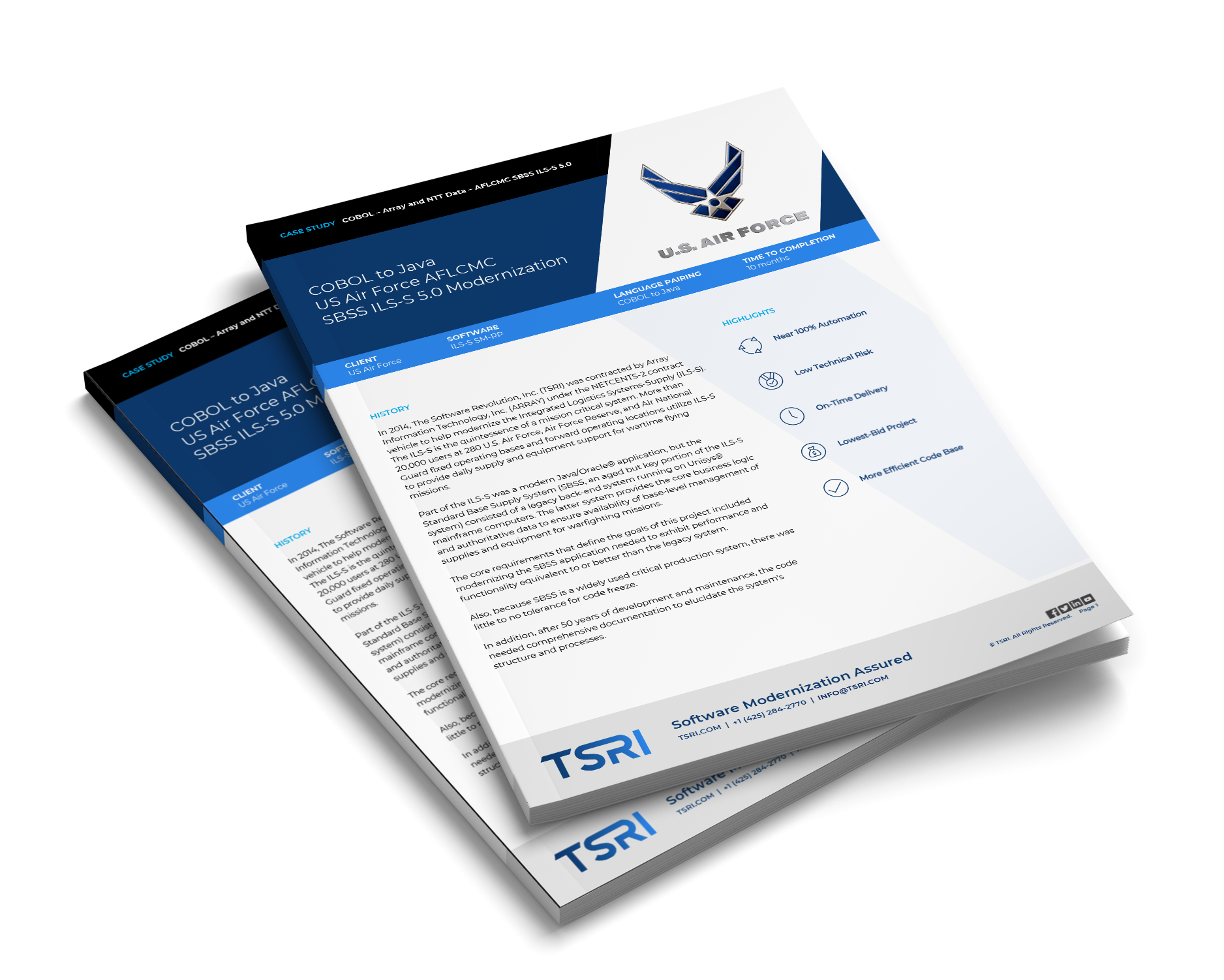
Ready to modernize? Reach out to us to learn more and get started!
-----
TSRI is Here for You
As a leading provider of software modernization services, TSRI enables technology readiness for the cloud and other modern architecture environments. We bring software applications into the future quickly, accurately, and efficiently with low risk and minimal business disruption, accomplishing in months what would otherwise take years.
Get started on your modernization journey today!
Virtual Event on May 18: Modernizing for the Future
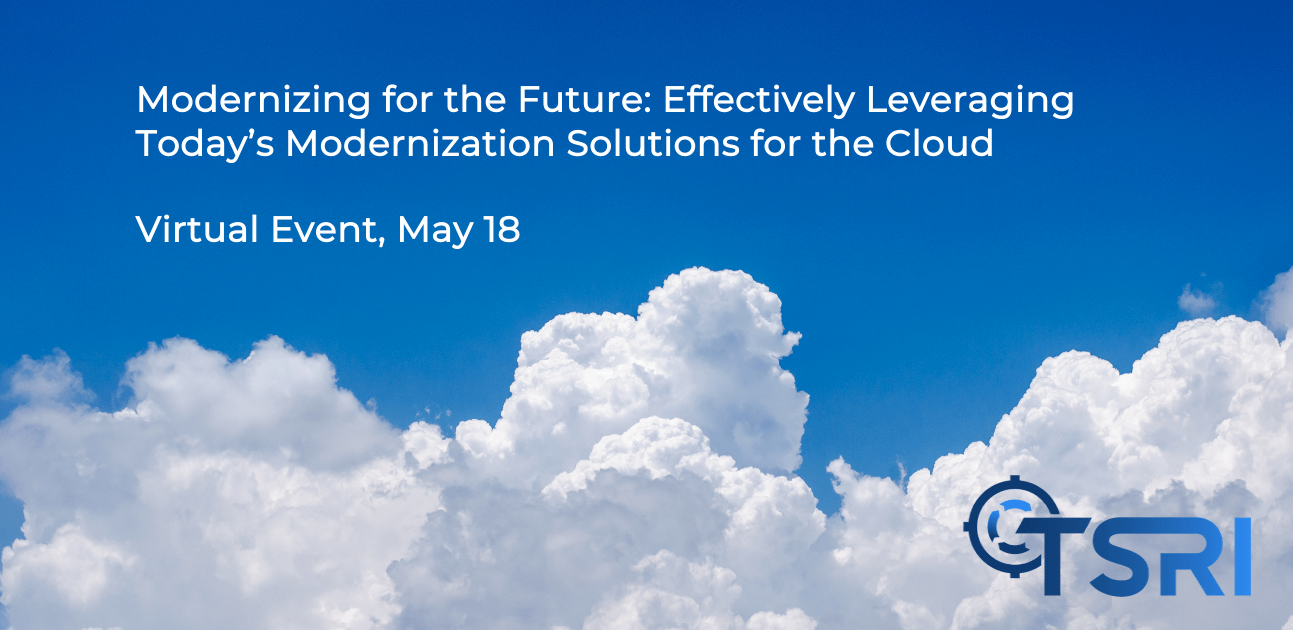
Any organization undergoing a modernization needs to understand the new environment they will be moving to. When it comes to cloud migration, the path to successful execution is not always clear.
TSRI’s VP of Product Development and Service Delivery, Scott Pickett, will lead a live virtual session to help organizations work through the benefits and challenges of modernizing for the cloud. Scott will reference case studies from many of the successful cloud migrations he and his team at TSRI have undertaken.
Modernizing for the Future: Effectively Leveraging Today’s Modernization Solutions for the Cloud
Tuesday, May 18 at 11:00am (PDT)
In this session, Scott will explain what the landscape of constantly evolving technology options means for organizations looking to modernize their code, databases, and UI as they move to the cloud. While the options at first may seem daunting, the insights Scott has gathered from many years in the field and numerous successful modernization and cloud-migration programs will ease a lot of anxiety among both business and IT professionals.
Scott’s session will be presented virtually with a live Q&A. Don’t miss your chance to attend this value-packed session!
Some key takeaways you can expect from Scott in this session:
- Gain important insights to successfully move beyond language modernization and support best practices for deployment in a cloud environment.
- Learn about common benefits, challenges, and pitfalls in cloud migration and modernization.
- Dive into the specifics associated with modernizing COBOL programs and the tools, services, and tech stacks required to support them in a modern environment.
Register now to participate on May 18 for this live-streaming event!
-----------
TSRI is Here for You
As a leading provider of software modernization services, TSRI enables technology readiness for the cloud and other modern architecture environments. We bring software applications into the future quickly, accurately, and efficiently with low risk and minimal business disruption, accomplishing in months what would otherwise take years.
Checklist: Preparing for Cloud Modernization

Is modernizing your software applications to the cloud a topic of discussion in your organization? Though a move to the cloud may not be the immediate next step in your organization’s IT strategy, it is likely that such a migration will eventually be critical to long-term success. If you’re contemplating (or already planning on) a move to the cloud and need to modernize your applications, then you need to be prepared.
With hundreds of large-scale modernizations under our belt, the TSRI team has seen the good, the bad, and the ugly. While no modernization effort is without its bumps, there are things you can do to pave an easier path. We’ve developed a checklist to give you a head start on your modernization journey to ensure success from the beginning!
Technical
Discovery on your existing mainframe
Conduct a technical assessment to help understand your existing systems to set a baseline for a transformation.
CODEBASE
![]() Existing languages (primary sub-languages)
Existing languages (primary sub-languages)
![]() Lines of code and comments
Lines of code and comments
![]() Readability and completeness of application documentation
Readability and completeness of application documentation
![]() Blackbox libraries
Blackbox libraries
DATABASES
![]() Database platform(s) & versions(s)
Database platform(s) & versions(s)
![]() Database Metrics (Size, Tables, Columns, etc.)
Database Metrics (Size, Tables, Columns, etc.)
![]() Database type(s), e.g., flat file, relational, mid-range, etc.
Database type(s), e.g., flat file, relational, mid-range, etc.
![]() Connection nodes to application codebase & other services
Connection nodes to application codebase & other services
SCREEN (user interface)
![]() Types (graphical or text-based)
Types (graphical or text-based)
![]() Interoperability between applications
Interoperability between applications
![]() Usability
Usability
![]() Feature assessment
Feature assessment
-
SERVICES
![]() Licensing agreements
Licensing agreements
![]() Tool feasibility
Tool feasibility
![]() Assessment of needs
Assessment of needs
-
OTHER METRICS
![]() MIPS consumption
MIPS consumption
![]() Transactions & transaction volumes
Transactions & transaction volumes
![]() Third-party tools & services
Third-party tools & services
![]() Customized tools
Customized tools
![]() Undocumented tools (may be discoverable via an application blueprint process)
Undocumented tools (may be discoverable via an application blueprint process)
Physical Mainframe Review
Examines system architecture, technical services in use, and analysis of both internal and external services/applications. We can use this information to map your system to your desired target services and architecture.
![]() Existing architecture survey
Existing architecture survey
![]() Architecture diagram evaluation
Architecture diagram evaluation
![]() External applications assessment
External applications assessment
![]() Utilities and services assessment
Utilities and services assessment
![]() Services overlap within the full application portfolio
Services overlap within the full application portfolio
![]() Performance, quality, and security baselines and metrics
Performance, quality, and security baselines and metrics
SMEs/Personnel
While the technical review is important, it’s also useful to have an understanding of who on the team is able to maintain and develop on your existing systems. The logic and technical requirements may be different once you’ve established your target architecture.
![]() Survey of staffing (existing and future)
Survey of staffing (existing and future)
![]() Assessment of team’s working knowledge of applications
Assessment of team’s working knowledge of applications
![]() Talent assessment within market
Talent assessment within market
As you gather this information, TSRI uses its tools to assess the code, find any code modules/segments within applications that are no longer in use, and generate code-level documentation through a blueprint preview of the current codebase and what a future, modernized codebase might look like. We will then work with you to establish business requirements. Note that while many of these tasks individually take a short time, depending upon the number of applications and the size of your application portfolio, an end-to-end engagement can range anywhere from 1-2 years if your systems have fewer than 10 million lines of code to transform to 4-5 years for much larger portfolios and codebases.
Business
Business case development and financial discovery
Once you have completed a technical analysis and your IT leaders understand your existing systems, it is time to establish your organization’s business cases to modernize your applications and support a modern environment.
-
-
NEEDS ASSESSMENT
![]() Timeframe for project phases and project completion
Timeframe for project phases and project completion
![]() Market and internal demands
Market and internal demands
![]() Then vs. now: evolution of your customer and business needs
Then vs. now: evolution of your customer and business needs
![]() Modern workflows and accessibility
Modern workflows and accessibility
![]() Security posture
Security posture
-
-
CURRENT FINANCIAL STATE
-
![]() Total cost of mainframe and application ownership
Total cost of mainframe and application ownership
![]() Mainframe operating expenses
Mainframe operating expenses
![]() Capital expenditures
Capital expenditures
![]() Amortized costs
Amortized costs
-
-
INTANGIBLE COSTS BEYOND PRICE
-
![]() Market agility
Market agility
![]() Business requirements agility
Business requirements agility
![]() Availability of developers that support legacy systems
Availability of developers that support legacy systems
Download and print your own modernization checklist
While most businesses that rely upon mainframes will need to modernize in one way or another, every organization’s needs will be different. Base your organization’s decisions not just on the flashiest current technologies, but on the methodologies and technologies that will work best for your company today and into the future. TSRI can work with you to complete this checklist assessment to start you on the path of a fully automated mainframe modernization. Contact us now to begin!
TSRI is Here for You
As a leading provider of software modernization services, TSRI enables technology readiness for the cloud and other modern architecture environments. We bring software applications into the future quickly, accurately, and efficiently with low risk and minimal business disruption, accomplishing in months what would otherwise take years.
Get started on your modernization journey today!
Ada to Java and C++ - ITT / SENSOR
ITT Corporation awarded a sole-source contract to TSRI for modernization of the COBRA DANE Radar Calibration System (SCRS) of the Ballistic Missile Early Warning System (BMEWS) under the Air Force’s System Engineering & Sustainment Integrator (SENSOR) program.
- Customer & Integrator: US Air Force/ITT
- Source & Target Language: Ada to Java/C++
- Lines of Code: 380,300
- Duration: 8 months
- Services: Code Transformation, Automated Refactoring, System Integration, Testing & Implementation Support, Final “To-Be” Documentation
- ada
- C++
- Java
- itt
- Code Transformation
- Automatic Refactoring
- Final ToBe Documentation
- System Integration and Test Support
- System Integration
- usaf
- US Air Force
- modernization
- Refactor
- Refactoring
- html
- Remove Dead Code
- Common Coding Standards
- Software code Conversion
- Software Modernization
- ada to c++
- Software Design
COBOL to C# - Retail Client
A $39 billion clothing retailer with 4,300 stores worldwide sought to modernize its suite of mainframe COBOL supply chain applications. These applications supported the client’s unique business process, which provided them with a major competitive advantage and fueled years of unprecedented growth. Today, the clients business logic was preserved and their services are hosted on Azure with data integration directly through service bus queues and scheduling handled via Logic Apps.
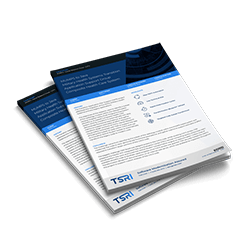 |
Customer: Retail Client Source & Target Language: COBOL to C# Lines of Code: 86,000 Duration: 3 months Services: Code Transformation, Automated Refactoring, Testing and Implementation Support, Transformation Blueprint®
|
Ada to C++ - Raytheon - TCS / MCS
Navy Multi-band Terminal (NMT) is a SATCOM terminal, which expands available bandwidth and provides support for ForceNet, the Navy's approach to network-centric operations. TSRI transformed the legacy Ada code to C++, and refactored the modernized application.
- Customer & Integrator: Raytheon & US Navy
- Source & Target Language: Ada to C++
- Lines of Code: 89,000
- Duration: 5 months
- Services: Automated Code Transformation, Transformation Blueprint, System Integration and Test Support, Automated Refactoring
